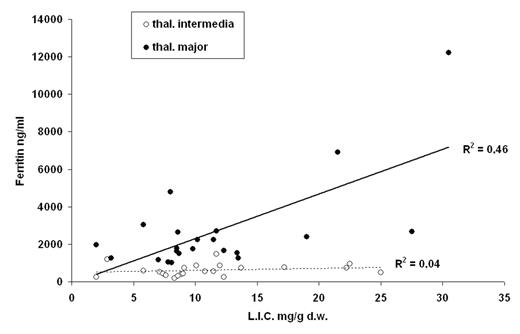Abstract
Serum ferritin and liver iron concentration (LIC) are the most commonly used methods for assessment of iron overload in thalassemia. While in patients with thalassemia major a significant correlation has been found between these two parameters, data are lacking in patients with thalassemia intermedia. In this study we measured the serum ferritin and LIC in 22 adult patients with beta-zero thalassemia intermedia never transfused (14 patients) or sporadically transfused, i.e. less than 10 units in total (8 patients), who maintained a mean hemoglobin of 8.8 ± 1.1 g/dl. Serum ferritin levels were measured by an automated chemiluminescence immunoassay analyzer, whereas LIC was determined by atomic absorption in liver biopsies. We compared the results obtained in those patients with those obtained in 22 regularly transfused (mean annual Hb = 11.3 ± 0.3 g/dl) and iron chelated thalassemia major patients, matched by sex, age and liver iron concentration. We also determined serum erythropoietin (s-epo) and serum transferrin receptor (s-TfR) in a cohort of the two patient groups (12 thalassemia intermedia; 15 thalassemia major). Mean LIC was 11.3 ± 6 mg/g dry weight tissue in thalassemia intermedia, and 11.8 ± 7 mg/g d.w. in thalassemia major group. Mean serum ferritin (at least 2 determinations from each patient within ± 2 months of liver biopsy) was 627 ± 309 ng/ml in thalassemia intermedia and 2748 ± 2510 ng/ml in thalassemia major. The difference was statistically significant (p = 0.0001). LIC was weakly correlated with serum ferritin in thalassemia major patients (r2=0.46; p=0.001) and uncorrelated in patients with thalassemia intermedia (r2=0.04; p=0.37) (Figure). S-epo and s-TfR were significantly higher in thalassemia intermedia than in thalassemia major [s-epo 467 ± 454 mU/ml versus 71 ± 44 mU/ml (p<0.001); s-TfR 43 ± 13 mU/ ml versus 13 ± 6 mU/ml (p<0.0001)]. The discrepancy between LIC and serum ferritin in thalassemia intermedia patients may be due to the higher levels of s-epo (secondary to anemia) in those patients, which through the iron regulatory protein 1 determine an up-regulation of s-TfR and a repression of ferritin translation (Weiss et al 1997). The mechanism of iron overload may also be mediated by hepcidin, whose synthesis could be suppressed as a consequence of anemia. The observation reported has important implications for iron chelation in patients with thalassemia intermedia. In such patients serum ferritin levels have little value for the monitoring of iron overload.
Author notes
Corresponding author


This feature is available to Subscribers Only
Sign In or Create an Account Close Modal